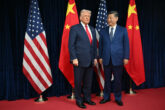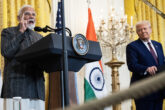February 04, 2021
A Sharper Approach to China’s Military-Civil Fusion Strategy Begins by Dispelling Myths
The U.S. senators who found time to ask Treasury Secretary nominee Janet Yellen about China’s military-civil fusion showed how widespread have become concerns about Beijing’s efforts to blur the lines between the country’s military and civilian entities. But the Trump administration’s oft-hyperbolic messaging about MCF has given rise to myths and several misperceptions. To confront the threat appropriately, the Biden administration will need a more sophisticated understanding of this strategy—and that will require separating facts from fictions.
Make no mistake: the concerns are legitimate. Amid Beijing’s drive to create a world-class military, Chinese companies have, on several occasions, acquired sensitive technology and stealthily transferred it to the country’s military. But the problem is also misunderstood or mischaracterized, such as when the Trump administration tried to ban TikTok, the Chinese social media platform, in part for being an “active” participant in MCF — but could produce scant evidence of national security harm.
First, MCF is not an invention of Xi Jinping.
Our new CNAS report, “Myths and Realities of China’s Military-Civil Fusion Strategy,” tackles several prominent misconceptions.
First, MCF is not an invention of Xi Jinping. While it can be tempting to view MCF as another manifestation of Xi’s China—which has been marked by growing repression and state control—MCF builds upon decades of efforts to attract private companies to defense research and procurement. These past initiatives achieved, at best, limited success, demonstrating the difficulty of achieving true “fusion” in practice.
Read the full article on Defense One.
More from CNAS
-
Indo-Pacific Security / Energy, Economics & Security
How to Win the Economic War with ChinaTrump's approach to China has run aground, giving Beijing unprecedented advantage in the economic conflict....
By Edward Fishman & Julian Gewirtz
-
America’s Self-Loathing Is a Losing Hand
This article was originally published in The Washington Post.Around 10 years ago, the United States began a historic shift in its grand strategy toward China, abandoning the b...
By David Feith
-
Indo-Pacific Security / Energy, Economics & Security / Technology & National Security
Selling AI Chips Won’t Keep China Hooked on U.S. TechnologyU.S. policy should not rest on the illusion that selling chips can trap China inside the American tech ecosystem....
By Janet Egan
-
Will New Delhi-Beijing Move Beyond Friction Points? | Ex-White Official On India-China Reset
Prime Minister Narendra Modi on Friday said that India and China, as two major economies, must work together to bring stability to the global economic order. NDTV's Gaurie Dwi...
By Lisa Curtis




